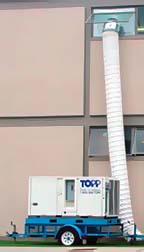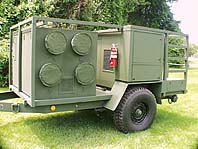At any given location, power supplies may be inadequate, causing problems with equipment operation. Or, the individuals setting up the equipment may not be familiar with what the equipment can tolerate. The latter can result in flex ducts either being too long for the external static pressure capability or choking off the return and supply air.
Also, the environment in which the portable unit is placed can be less than desirable. The units may be surrounded by corrosive elements, harsh weather, and/or extreme heat. It can all be in a day's work for a rugged portable unit.

Military Applications
The military probably has the corner on the market as far as using portable units in unforgiving environments. The various divisions buy thousands of portable units every year to send overseas or to use stateside. With the current conflicts taking place in locations such as Iraq and Afghanistan, many portable units are being shipped overseas to keep the troops comfortable.Donald Thompson, customer support manager, TOPP Portable Air, headquartered in Aston, Pa., said that the military is currently buying a variety of portable cooling units. As a preferred distributor for MovinCool, TOPP supplies all branches of the military with a full line of portable cooling options. "The military often uses these units to cool their tents, as well as their sensitive electronic equipment."
Given the extreme temperatures, it's necessary to provide military customers in desert locations with powerful cooling units.
Daniel P. Topp, president, TOPP Portable Air, noted, "Our range of customers must have the highest quality portable air conditioners that are available on the market today. Military, industrial, special event, and construction applications all require durable, reliable, and rugged equipment to withstand harsh indoor, as well as outdoor, environments."

Requests are often made by the military for portable units to operate at higher design temperatures. "Most commercial units are designed for 95 degrees F outside ambient," said Beever. "A number of the military departments are coming to us and saying they want them to operate at a design point of 120 degrees F."
The units used by the military also must be more durable than standard commercial units. For example, if the unit is going to be dropped out of a plane, it has to be rugged enough to withstand the fall to the ground. The military units often have a special coating designed to keep corrosive elements at bay. Special care must be taken for anticipated uses where sand, dust, and dirt can clog coils and filters.
The toughest military environment that a portable unit is likely to experience is on a hovercraft. The salt spray is corrosive, and the excessive vibration could mean trouble for a standard portable unit.
"For the units going on hovercrafts, we put a Heresite coating on the coils and on a majority of the sheet metal," said Beever. "The units are also designed to handle shock and vibration." The newer units can usually last two or three years in these conditions.
Thompson noted that units placed in desert regions can last many years, provided they are serviced regularly.

Disaster Relief
Besides military use, portable units may also be exposed to harsh conditions during the cleanup of disasters. For example, last August the main library at the University of Georgia (UGA) in Athens, Ga., caught fire, sustaining considerable damage to the building's second floor.Although efforts to prevent damage were swift, the second and third floors of the UGA library suffered from fire damage, as well as some water damage from firefighters' hoses. All nine floors were contaminated by soot and smoke distributed by the HVAC system, which continued operating during the fire.
Fortunately, the fire dampers on the second floor did close rather quickly, which helped contain the smoke to that floor. The library had to close right before fall semester in order to clean up the mess.
A restoration contractor arrived immediately to begin the cleanup process, which consisted of re-moving all water and moisture caused by the fire hoses and removing all soot and smells associated with smoke damage. To that end, trailer-mounted dehumidifiers were brought in immediately to begin the drying process before mold or mildew began to grow.

While the duct system was being cleaned for over six weeks, the building's cooling system had to be shut down. NuTemp Inc.'s Marietta, Ga., office provided 640 tons of temporary cooling, consisting of two chillers, seven air handlers, and 60 spot coolers for cooling and dehumidification of the UGA library. Rental generators were used to provide temporary power for all of the rental cooling and dehumidification equipment.
Thousands of feet of 20-inch flexible air duct were installed on the outside of the building to blow cold air into windows on each floor. The entire project was delivered and set up within 72 hours of the initial request. NuTemp sent five trained technicians to assist with project setup and to make sure the equipment operated smoothly. NuTemp staffed the project 24 hours a day, seven days a week for six weeks.
The upside to this disaster, said Don Schrampfer, marketing director, NuTemp, is that the news coverage for this high-profile event created numerous inquiries from companies wanting to create a disaster recovery plan for their facilities.
"A facility damaged by fire, water, wind, or other events can cripple a company's operations," he said. "Proper planning can lessen the financial impact of a disaster."
No matter how harsh the conditions may be, chances are there's a portable unit available to help out.
Publication date: 02/09/2004


Report Abusive Comment